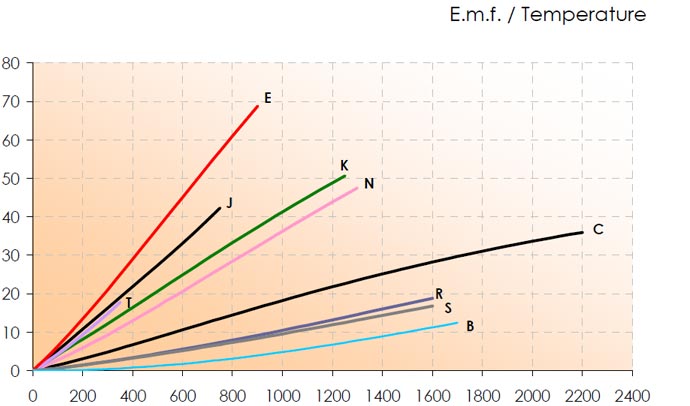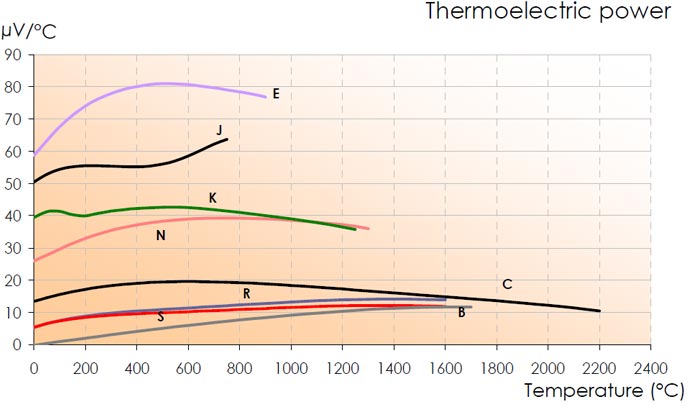Thermocouples
What is temperature?
Temperature is a physical« quantity » which follows the thermodynamics laws. The temperature unit (T symbol) is the Kelvin (K symbol) defined as a fraction of the thermodynamic temperature of the triple point of water (1/273.16).For temperature above the triple point of water, it is useful to take the Celsius temperature (t symbol) of which the unit is the Celsius degree (°C symbol)t = T – 273.15 273.15 being the thermodynamic temperature of the melting point of water. Apart from highly specialized laboratories, it is extremely difficult to use the thermodynamic thermometers (gas dilatation, radiation) so the idea to use other phenomenon:
- change of electrical resistivity in metal
- e.m.f. of thermocouples
gave rise to the development of appropriate sensors. In order to find the relationships between the temperature and the electrical property of the sensors, they have to be measured and compared at given temperature levels, thus temperature scales were created.
These scales are often represented by “fixed points” which are temperatures where pure elements change their physical states:
- melting (solid to liquid),
- freezing (liquid to solid),
- boiling (liquid to gas),
- triple point (liquid, solid and gas).
Interpolations between these points are made by thermometers which are extremely accurate and precise for given temperature ranges. For the ITS-90, this means:
- 0.65 to 5 K: saturant vapor pressure of 3He, 4He,
- 3 to 24.5 K (Ne): helium gas thermometers,
- 13.84 (H2) to 961.78°C (Ag): platinum resistance sensors,
- ≥961.8°C: pyrometer (Planck law).
Historical background
The technical application of thermoelectric effect for temperature measurement began with Professor Le Chatelier. The development continues as new thermocouple materials are tested.
Generally, any combination of two different conductor materials can be used as a thermoelectric wire.
If two different materials are welded to make a hot junction and heated up, an electromotive force (e.m.f.) is generated to make the temperature measurement possible. The sensitivity of the thermocouple is the sum of the thermoelectric power of each conductor.
The sensitivity is very high if there is a big difference between the thermoelectric power of these conductors.
The first thermocouples, developed by Professor Le Chatelier, had the inconvenience that the thermoelectric wires were made of pure metals.
Even light contamination (during production or later during the use) had a negative influence on the thermocouple quality. During production, a lot of care has to be taken over the purity and cleanness of the metals. Therefore, the production process was very complicated. At the beginning of the last century, the American company Hoskins developed the Nickel-Chromium / Nickel alloy thermocouple. In this case, both wires were made of alloys. Slight contamination of these materials does not have any negative influence on the measurement quality. This development of new thermocouples was a great improvement. Despite of the advantage, this thermocouple type was not able to supersede the Cu-CuNi and the Fe- CuNi thermocouples in the low temperature segment. The advantage of a higher e.m.f. means a better temperature resolution. Moreover, an almost linear thermoelectric power within its temperature range makes the type K thermocouple the most widely used among all.
Over the past years, only a limited number of thermocouples managed to impose themselves on the market. The thermocouples have been standardized in the industrialised countries. The basic values of the e.m.f. and the tolerances are laid down in the IEC584-1+2 standards. Thermocouples cover a temperature range from -200°C to +2300°C.
The measurement of temperature is a very important element in many parts of research and industry. A well-known and proven method in temperature measurement is the use of thermocouples.
Accurate and fast measurements, easy mounting, simple utilization and interchangeability as well as low-cost production are the reasons for the widespread applications of the thermocouples. They are resistant to heat and pressure and relatively insensitive top parasites.
Specific technical requirements like within nuclear reactors, in space research or in medical fields led to the development of sheathed thermocouples of small dimensions, high insulation resistance and high resistance to aggressive media.
All this is being fulfilled by miniature sheathed thermocouples.


